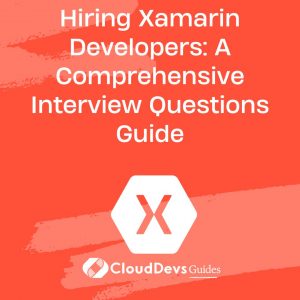Hiring Xamarin Developers: A Comprehensive Interview Questions Guide
In the realm of cross-platform mobile app development, Xamarin has emerged as a powerful framework that allows developers to create native apps for various platforms using a single codebase. To navigate the process of hiring Xamarin developers effectively, this guide equips you with essential interview questions and strategies to identify top-tier candidates with the technical expertise, problem-solving acumen, and Xamarin proficiency your team requires.
Table of Contents
1. How to Hire Xamarin Developers
Embark on your journey of hiring Xamarin developers with these strategic steps:
- Job Requirements: Define specific job prerequisites outlining the desired skills and experience for your Xamarin development role.
- Search Channels: Utilize job boards, online platforms, and developer communities to discover potential Xamarin developer candidates.
- Screening: Evaluate candidates based on their Xamarin proficiency, mobile app development skills, and supplementary knowledge.
- Technical Assessment: Develop a comprehensive technical evaluation to assess candidates’ coding abilities, understanding of cross-platform development, and problem-solving capabilities.
2. Key Skills to Look for in Xamarin Developers
When evaluating Xamarin developers, prioritize these core skills:
- Xamarin Proficiency: A deep understanding of Xamarin’s architecture, components, and toolset for building cross-platform mobile apps using C# and .NET.
- Mobile App Development: Proficiency in mobile app development principles, including user interface design, navigation, data storage, and performance optimization.
- C# and .NET Knowledge: Expertise in C# programming language and .NET framework, as Xamarin relies on these technologies to create cross-platform applications.
- UI/UX Design: Familiarity with designing intuitive and user-friendly mobile app interfaces using Xamarin.Forms or Xamarin.Native.
- Platform-specific APIs: Experience in utilizing platform-specific APIs and features to provide a native-like experience on both Android and iOS devices.
- Version Control: Proficiency in using version control systems like Git to collaborate effectively with team members on codebases.
3. Xamarin Developer Hiring Process Overview
Here’s a high-level overview of the Xamarin developer hiring process:
3.1 Define Job Requirements and Skillsets
Lay a strong foundation by outlining clear job requirements, specifying the skills and experience you’re seeking in Xamarin developer candidates.
3.2 Craft Compelling Job Descriptions
Create engaging job descriptions that accurately convey the responsibilities and opportunities associated with the Xamarin development role.
3.3 Develop Xamarin Developer Interview Questions
Design a comprehensive set of interview questions covering Xamarin intricacies, mobile app development concepts, cross-platform challenges, and Xamarin.Forms/Xamarin.Native.
4. Sample Xamarin Developer Interview Questions and Answers
Explore these sample questions and answers to assess candidates’ Xamarin skills:
Q1. Explain the difference between Xamarin.Forms and Xamarin.Native. When would you choose one approach over the other for mobile app development?
A: Xamarin.Forms is a UI toolkit that allows you to create a single user interface that can be shared across platforms. Xamarin.Native involves creating separate user interfaces for each platform. Use Xamarin.Forms for simple apps with consistent UI, and Xamarin.Native for more complex apps with platform-specific UI requirements.
Q2. Describe the process of creating a new Xamarin.Forms project. What are the essential components and files in a Xamarin.Forms solution?
A: To create a Xamarin.Forms project, you’d use the appropriate project template in Visual Studio or Xamarin Studio. Essential components include XAML files for UI layout, C# code-behind files for logic, and platform-specific projects for rendering the UI on Android and iOS.
Q3. Implement a Xamarin.Forms page that displays a list of items using a ListView. Provide a brief explanation of the code.
using Xamarin.Forms;
public class Item {
public string Name { get; set; }
}
public class MainPage : ContentPage {
public MainPage() {
var items = new List<Item> {
new Item { Name = "Item 1" },
new Item { Name = "Item 2" }
};
var listView = new ListView { ItemsSource = items };
Content = listView;
}
}
Q4. How does Xamarin handle platform-specific code and APIs? Provide an example of using platform-specific code in a Xamarin project.
A: Xamarin allows you to use platform-specific code using DependencyService or custom renderers. Here’s an example of using DependencyService to show a native alert:
// Interface
public interface IAlertService {
void ShowAlert(string message);
}
// Android implementation
[assembly: Dependency(typeof(AlertService))]
namespace YourNamespace.Droid {
public class AlertService : IAlertService {
public void ShowAlert(string message) {
AlertDialog.Builder alert = new AlertDialog.Builder(Android.App.Application.Context);
alert.SetMessage(message);
alert.Create().Show();
}
}
}
// Usage in Xamarin.Forms
DependencyService.Get<IAlertService>().ShowAlert("Hello, Xamarin!");
Q5. Explain the purpose of Xamarin.Essentials. How can you use Xamarin.Essentials to access device features and functionalities?
A: Xamarin.Essentials is a library that provides cross-platform APIs to access device features such as camera, location, sensors, and more. It simplifies the process of interacting with device-specific capabilities using a single API.
Q6. Describe the process of handling navigation in Xamarin.Forms. How can you navigate between pages and pass data between them?
A: In Xamarin.Forms, navigation involves using NavigationPage and Page classes. To navigate between pages, you push and pop pages onto and from the navigation stack. You can pass data between pages using constructor parameters or binding contexts.
Q7. Explain the concept of data binding in Xamarin.Forms. How can you use data binding to create responsive and dynamic UIs?
A: Data binding in Xamarin.Forms allows you to establish a connection between UI elements and data sources. It ensures that changes in data are automatically reflected in the UI, making it easier to create responsive and dynamic user interfaces.
Q8. What are custom renderers in Xamarin? How can you create a custom renderer to customize the appearance of a control on each platform?
A: Custom renderers in Xamarin allow you to customize the appearance and behavior of controls on each platform. You can create a custom renderer by extending the platform-specific renderer classes and implementing the necessary methods to modify the control’s behavior.
Q9. Describe the process of testing a Xamarin app. What are the different testing approaches and tools available for Xamarin applications?
A: Testing a Xamarin app involves unit testing, UI testing, and performance testing. For unit testing, you can use NUnit or MSTest. For UI testing, Xamarin.UITest allows you to write tests that simulate user interactions. Xamarin Test Cloud (now part of Visual Studio App Center) is used for automated testing on multiple devices.
Q10. How can you optimize the performance of a Xamarin app? Mention some strategies and techniques.
A: Xamarin app performance optimization involves techniques like minimizing memory usage, optimizing UI rendering, using asynchronous programming, and reducing network requests. Also, profile your app using Xamarin Profiler to identify bottlenecks and performance issues.
5. Hiring Xamarin Developers through CloudDevs
Step 1: Connect with CloudDevs: Initiate a conversation with a CloudDevs consultant to discuss your Xamarin development project’s specifics, preferred skills, and desired experience levels.
Step 2: Discover the Perfect Match: Within a short timeframe, CloudDevs presents you with carefully selected Xamarin developers from their network of pre-vetted professionals. Review their profiles and select the candidate whose expertise aligns seamlessly with your project’s vision.
Step 3: Embark on a Trial Engagement: Engage in discussions with your chosen developer to ensure a seamless integration into your team. Once satisfied, formalize the collaboration and embark on a risk-free trial period spanning one week.
By leveraging the expertise of CloudDevs, you can seamlessly identify and hire top-tier Xamarin developers, ensuring your team possesses the skills necessary to craft exceptional cross-platform mobile applications.
6. Conclusion
With these comprehensive interview questions and insights at your disposal, you’re well-prepared to assess Xamarin developers comprehensively. Whether you’re building native-like mobile apps for Android and iOS or creating cross-platform solutions, securing the right Xamarin developers through CloudDevs is pivotal for the success of your mobile app development projects.
Table of Contents







